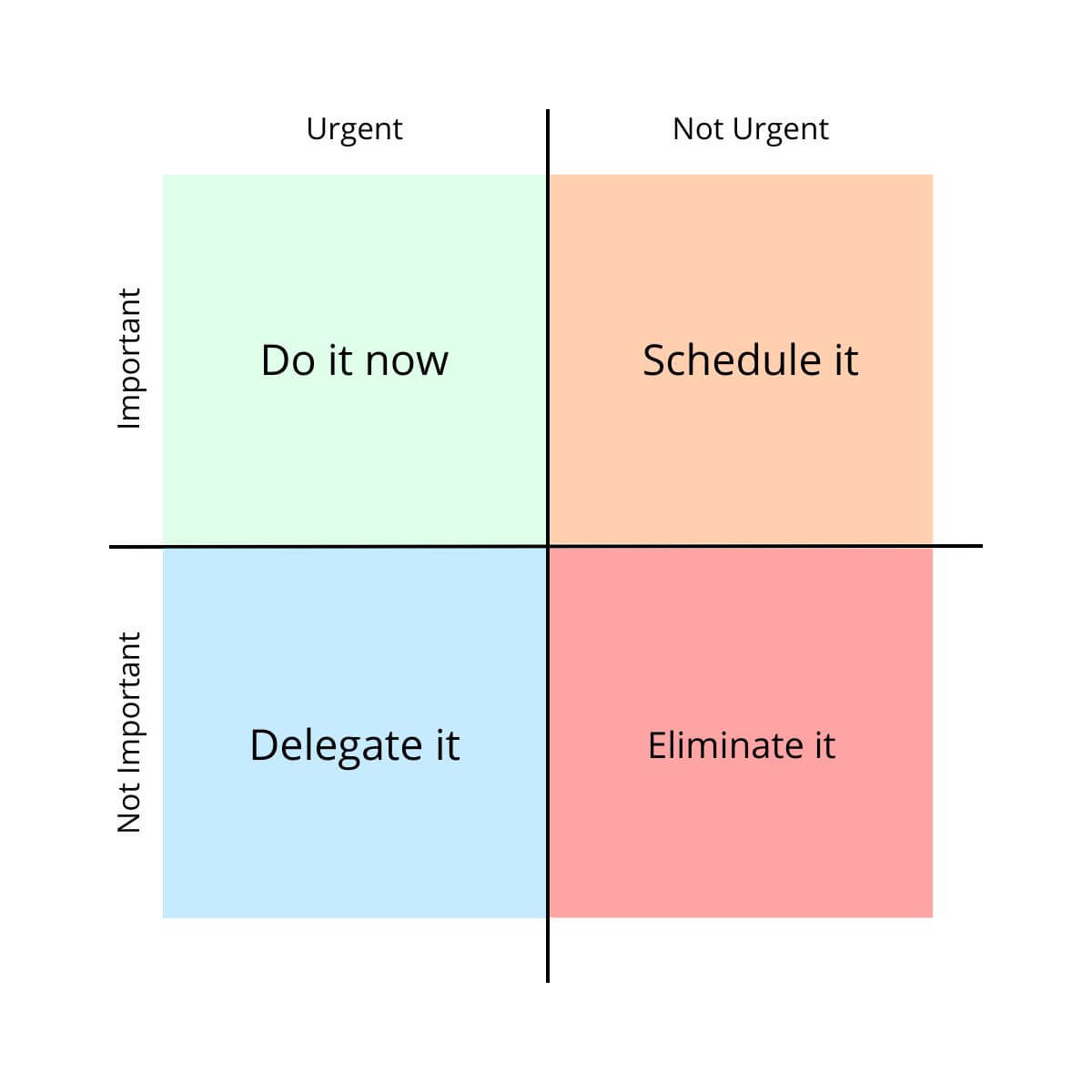Eisenhower Matrix

Introduction
Ever feel like your whole day is one long emergency? Your inbox is exploding, Slack won’t shut up, and you haven’t even started the big project due Friday. You’re putting out fires – but nothing truly important gets done.
If that sounds like you, you’re not alone. Urgency overload is one of the most common stressors for modern professionals. It’s not that you’re lazy or bad at planning. It’s that your brain is constantly reacting instead of deciding.
There’s a better way to take back control of your time – and it starts with a simple 2×2 grid. Meet the Eisenhower Matrix.
In This Article
- The Problem
- What’s Really Going On
- The Solution: The Eisenhower Matrix
- What Most People Get Wrong
- Try It Yourself
- Final Thoughts
The Problem
Let’s be real: your to-do list probably looks like a war zone. Calls to return. Emails to answer. Meetings to prep. Bills to pay. Groceries. Gym. That half-finished presentation. All of it feels urgent, so you keep bouncing between tasks like a pinball.
The result? You’re exhausted, distracted, and somehow still behind.
This cycle – constantly reacting to what’s loudest or most recent leads to burnout and shallow work. You never get to the stuff that actually moves the needle, because you’re always cleaning up after yesterday’s chaos. Important projects get delayed. Strategic goals stay on the back burner. Your sense of progress vanishes.
And here’s the thing: it’s not just you. We’re living in a culture that rewards immediacy. Fast replies get praise. Busyness gets mistaken for productivity. No wonder we feel guilty slowing down or saying no.
But here’s the truth: not everything urgent is important. And if you treat them the same, you’ll stay stuck in survival mode.
What’s Really Going On
Your brain is wired to react to urgency. It triggers a hit of dopamine – the same brain chemical involved in reward and motivation. So when your phone buzzes or your inbox pings, your brain perks up like, “Ooh, something important!”
But urgency isn’t the same as importance. Urgent tasks shout. Important tasks whisper.
In survival mode, the brain favors short-term wins over long-term thinking. That’s great for escaping lions – not so great for focusing on deep work, strategy, or self-care.
Here’s what your brain is actually doing: it confuses speed with significance. And without a system, you’ll keep reacting instead of choosing.
The Solution: The Eisenhower Matrix
What It Is
The Eisenhower Matrix also known as the Urgent-Important Matrix – is a time management tool that helps you prioritize tasks based on two criteria: urgency and importance.
You divide tasks into four quadrants:
- Important + Urgent: Do it now.
- Important + Not Urgent: Schedule it.
- Not Important + Urgent: Delegate it.
- Not Important + Not Urgent: Eliminate it.

This framework is named after President Dwight D. Eisenhower, who famously said: “What is important is seldom urgent and what is urgent is seldom important.”
Why It Works
It breaks the autopilot. Instead of jumping on what feels loudest, you pause and evaluate. This moment of reflection is key – it shifts you from reactive to strategic.
It also aligns your actions with your goals. Over time, you reduce last-minute scrambles and focus more on high-value tasks that actually matter.
How To Use It
- List your tasks. Write down everything you need to do – big or small.
- Label each one. Ask: Is this urgent? Is it important? Be honest.
- Sort into quadrants. Use the 2×2 matrix to place each task where it belongs.
- Take action.
- Quadrant 1: Do it ASAP.
- Quadrant 2: Schedule time in your calendar.
- Quadrant 3: Delegate if possible.
- Quadrant 4: Let it go.
Example
Let’s say your list includes:
- Finish client report (Important + Urgent)
- Plan next month’s strategy (Important + Not Urgent)
- Answer team Slack messages (Not Important + Urgent)
- Scroll Instagram for ideas (Not Important + Not Urgent)
With the Matrix:
- Report = Do now
- Strategy = Schedule
- Slack = Delegate or limit
- Instagram = Cut
What Most People Get Wrong
Many people love the idea of the Matrix – but then never actually use it.
Why? A few traps:
- They skip the labeling. Rushing through the task list, they just guess what’s urgent, without really questioning.
- They ignore Quadrant 2. This is the sweet spot – strategic, thoughtful work that builds your future. But since it’s not urgent, it gets pushed aside.
- They treat delegation as avoidance. Delegating doesn’t mean you’re lazy. It means you’re focused. You’re not the best person for every task and that’s okay.
- They overestimate urgency. Just because someone wants a reply fast doesn’t mean it’s critical. Learn to pause and assess.
If you misuse the Matrix, it turns into just another to-do list. But if you treat it like a filtering lens, it can transform how you approach every single day.
Try It Yourself
Want to test it out? Tonight, take 5 minutes to:
- List everything on your plate for tomorrow.
- Label each task as Urgent/Not Urgent and Important/Not Important.
- Place them into the Matrix.
- Decide on ONE action per quadrant.
Optional prompt: What task have you been avoiding that belongs in Quadrant 2?
This mini-exercise can reset your day before it even begins.
Final Thoughts
You can’t control how many things demand your attention. But you can control how you respond.
The Eisenhower Matrix gives you that pause – a way to step back, sort the noise, and focus on what matters most.
If you’ve ever felt stuck in urgency, this tool could be the start of real change.
You’ve got this.
